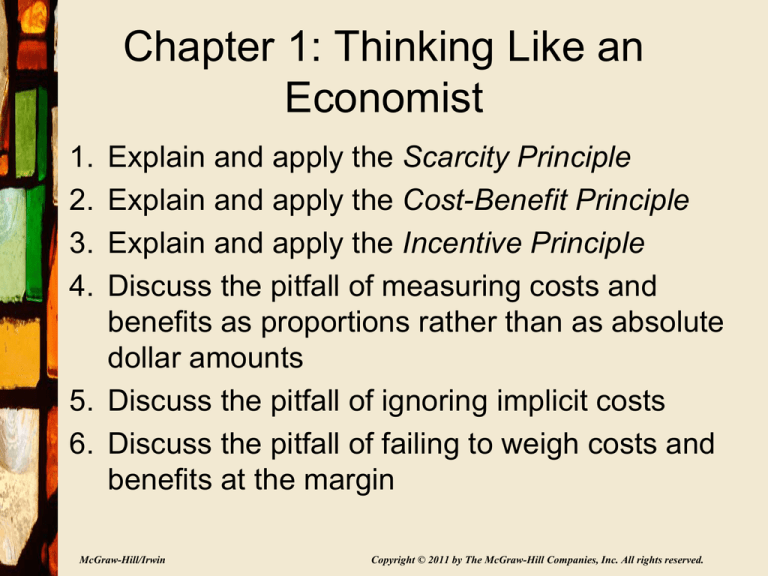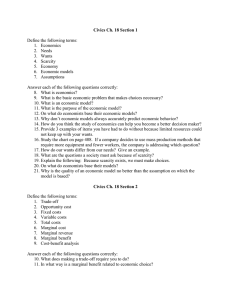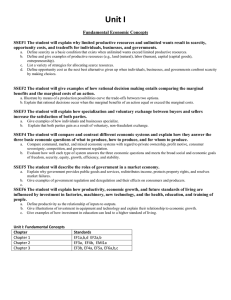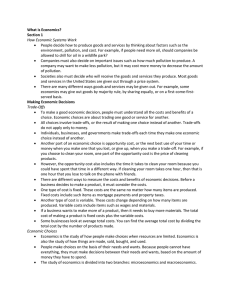
Chapter 1: Thinking Like an
Economist
1.
2.
3.
4.
Explain and apply the Scarcity Principle
Explain and apply the Cost-Benefit Principle
Explain and apply the Incentive Principle
Discuss the pitfall of measuring costs and
benefits as proportions rather than as absolute
dollar amounts
5. Discuss the pitfall of ignoring implicit costs
6. Discuss the pitfall of failing to weigh costs and
benefits at the margin
McGraw-Hill/Irwin
Copyright © 2011 by The McGraw-Hill Companies, Inc. All rights reserved.
The Scarcity Principle
Economics: The study of how people
make choices under scarcity and the
results of these choices for society.
The Scarcity Principle: People have
unlimited wants and limited resources.
Having more of one good means
having less of another.
Also called No Free-Lunch Principle
1-2
The Cost-Benefit Principle
• Take an action if and only if the extra benefits
are at least as great as the extra costs
• Costs and benefits are not just money
Marginal
Benefits
Marginal
Costs
1-3
Economic Surplus
• The economic surplus of an action is equal
to its benefit minus its costs
Total
Costs
Total Benefits
Economic
Surplus
1-4
Opportunity Cost
• Opportunity cost is the value of what must be
foregone in order to undertake an activity
– Consider explicit and implicit costs
• Examples:
– Give up an hour of babysitting to go to the movies
– Give up watching TV to walk to town
• Caution: NOT the combined value of all
possible activities
– Opportunity cost considers only your best
alternative
1-5
Economic Models
• Simplifying assumptions
– Which aspects of the decision are absolutely
essential?
– Which aspects are irrelevant?
• Abstract representation of key relationships
– The Cost-Benefit Principle is a model
• If costs of an action increase, the action is less likely
• If benefits of an action increase, the action is more
likely
1-6
Three Decision Pitfalls
• Economic analysis predicts likely behavior
• Three general cases of mistakes
1. Measuring costs and benefits as proportions
instead of absolute amounts
2. Ignoring implicit costs
3. Failure to think at the margin
1-7
Pitfall #1
Measuring costs
and benefits as
proportions
instead of
absolute amount
• Would you walk to
town to save $10 on
a $25 item?
• Would you walk to
town to save $10 on
a $2,500 item?
Marginal
Benefits
Marginal
Costs
Action
1-8
Pitfall #2
Ignoring implicit
costs
Explicit
Costs
Opportunity
Cost
Implicit
Costs
• Consider your
alternatives
– The value of a
Frequent Flyer coupon
depends on its next
best use
• Expiration date
• Do you have time for
another trip?
• Cost of the next best
trip
1-9
Pitfall #3
Failure to think at the
margin
• Sunk costs cannot be
recovered
– Examples:
• Eating at an all-youcan-eat restaurant
• Attend a second year
of law school
Marginal
Benefits
Marginal
Costs
1-10
Marginal Analysis Ideas
• Marginal cost is the increase in total cost
from one additional unit of an activity
– Average cost is total cost divided by the number
of units
• Marginal benefit is the increase in total
benefit from one additional unit of an activity
– Average benefit is total benefit divided by the
number of units
1-11
Normative and Positive
Economics
– Normative economic
principle says how
people should behave
• Gas prices are too
high
• Building a space base
on the moon will cost
too much
– Positive economic
principle predicts how
people will behave
• The average price of
gasoline in May 2008
was higher than in
May 2007
• Building a space base
on the moon will cost
more than the shuttle
program
1-12
Incentive Principle
Incentives are central to people's choices
Benefits
Costs
Actions are more likely
to be taken if their
benefits rise
Actions are less likely to
be taken if their costs
rise
1-13
Microeconomics and
Macroeconomics
Microeconomics studies
choice and its implications
for price and quantity in
individual markets
Sugar
Carpets
House cleaning services
Microeconomics considers
topics such as
Costs of production
Demand for a product
Exchange rates
Macroeconomics studies
the performance of national
economies and the policies
that governments use to try
to improve that performance
Inflation
Unemployment
Growth
Macroeconomics considers
Monetary policy
Deficits
Tax policy
1-14
Economics Is Choosing
• Focus in this course is on a short list of powerful
ideas
– Explain many economic issues
– Predict decisions made in a variety of
circumstances
• Core Principles are the foundation for solving
economic problems
1-15











